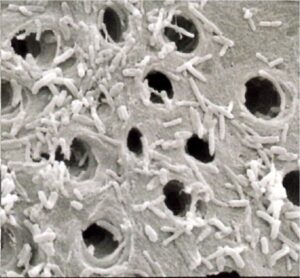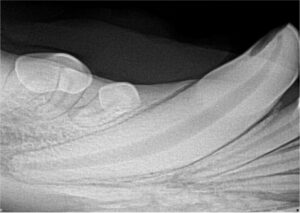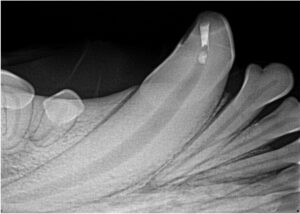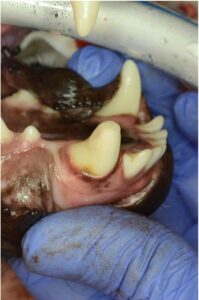
13 Sep Oh Dear! What Should I Do if My Dog Breaks a Tooth?
A recent study indicated that approximately 20-27% dogs have tooth fractures of some form. Some just nick the enamel (enamel fracture) and are mostly benign, other than causing localized trauma to the lip or tongue as it moves across the tooth. More sinister are tooth fractures that affect the underlying structures below the enamel called dentin. This type of tooth fracture is called an uncomplicated crown fracture. Because the dentin has microscopic pores present, bacteria can ingress and attack the tooth and potentially cause tooth death. A dental abscess of this variety is EXTREMELY painful to the pet. Finally, those fractures that expose the pulp are called complicated crown (or crown/root) fractures and these type of fractures can cause tooth death very quickly (as soon as 48 hrs). Therefore, action to prevent oral pain as well as tooth vitality requires quick action by the pet owner after a dog breaks a tooth.

Electron microscopy of dentin showing that bacteria can ingress to the dentin porules
This blog will address those tooth fractures that just occurred, and what treatment options are available. Just occurred means you know for sure the tooth fractured within 48 hrs. Let’s narrow this discussion to the type of tooth fracture as well to limit this to those that the pulp cavity is visible (see blood or red tinge on tip of fracture site). This tooth fracture is then defined as a complicated crown fracture that occurred within 48 hrs.
Treatment if a Dog Breaks a Tooth in the Last 48 Hours
When a tooth is broken and the pulp is exposed, this means the artery, vein, nerve and lymphatics of the tooth are now exposed to the environment. Bacteria can easily enter this fracture site and start the negative cascade of tooth death. At this point, the tooth is extremely sensitive and your pet is experiencing significant pain. In order to save the pulp cavity, treatment must be done within 48 hrs. The treatment plan for this tooth fracture is called a VITAL PULPOTOMY (or partial pulpectomy). The purpose of a vital pulpotomy is to place a sterile barrier at and just below the fracture site, thus allowing the tooth to continue to be vital. Vital means the tooth can continue to grow internally and there can be the positive effects of sensitivity that tells a dog or cat to stop pulling or tugging too much to avoid fracturing it further. This procedure is really important in younger pets (6 months to 2-3 years old) when the pulp cavity is wide and the dentin wall is thin. Performing a vital pulpotomy allows the tooth dentin wall (area surrounding the pulp cavity) to continue to grow, which is a good thing.
Below are pictures of a recent tooth fracture and vital pulp therapy.

Tooth fracture (complicated crown) into pulp cavity

Radiograph of tooth fracture

After vital pulp therapy

After vital pulp therapy and restoration
Performing vital pulpotomies are mostly relegated to maxillary and mandibular canine teeth, but other teeth that can receive this therapy are maxillary 3rd incisors, maxillary 4th premolars and mandibular 1st molars. If one does not choose vital pulp therapy for this acute tooth fracture, the only other treatment plan option is surgical removal of the tooth. Leaving this tooth in the mouth is not an option.
What happens if you notice your dog or cat have a fractured tooth with pulp exposure but you just don’t know when it occurred. For this, root canal therapy (total pulpectomy) is the treatment option, along with surgical extraction.
Final Thoughts
The maxillary and mandibular canine teeth are like the hands of your dog and cat. They are used to grab and hold on to things. Therefore, save the teeth, don’t pull them if at all practical. Your pet will appreciate it a lot.
Cheers!
Barden Greenfield, DVM, DAVDC Your Pet Dentist of Nashville
Image by Amal Santosh from Pexels


